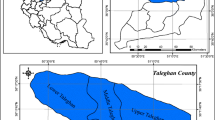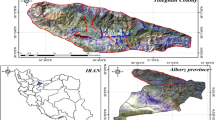Abstract
The ever-increasing development of cities due to population growth and migration has led to unplanned constructions and great changes in urban spatial structure, especially the physical development of cities in unsuitable places, which requires conscious guidance and fundamental organization. It is therefore necessary to identify suitable sites for future development of cities and prevent urban sprawl as one of the main concerns of urban managers and planners. In this study, to determine the suitable sites for urban development in the county of Ahwaz, the effective biophysical and socioeconomic criteria (including 27 sub-criteria) were initially determined based on literature review and interviews with certified experts. In the next step, a database of criteria and sub-criteria was prepared. Standardization of values and unification of scales in map layers were done using fuzzy logic. The criteria and sub-criteria were weighted by analytic network process (ANP) in the Super Decision software. Next, the map layers were overlaid using weighted linear combination (WLC) in the GIS software. According to the research findings, the final land suitability map was prepared with five suitability classes of very high (5.86 %), high (31.93 %), medium (38.61 %), low (17.65 %), and very low (5.95 %). Also, in terms of spatial distribution, suitable lands for urban development are mainly located in the central and southern parts of the Ahwaz County. It is expected that integration of fuzzy logic and ANP model will provide a better decision support tool compared with other models. The developed model can also be used in the land suitability analysis of other cities.





Similar content being viewed by others
References
Abdoli, M. A. (2006). Recycling of domestic solid waste. Tehran University, pp 25.
Ahsan, M. (2003). Collection of urban planning regulations and laws, first volume: from beginning to 1999. Tehran: Ministry of Housing and Urban Development, Urban Planning and Architecture Adjutancy, Urban Planning and Architecture Research Center of Iran.
Aragonés-Beltrán, P., Pastor-Ferrando, J. P., García-García, F., & Pascual-Agulló, A. (2010). An analytic network process approach for siting a municipal solid waste plant in the metropolitan area of Valencia (Spain). Journal of Environmental Management, 91(5), 1071–1086.
Arnous, M. O. (2013). Geotechnical site investigations for possible urban extensions at Suez City, Egypt using GIS. Arabian Journal of Geosciences, 6(5), 1349–1369.
Banai, R., & Wakolbinger, T. (2011). A measure of regional influence with the analytic network process. Socio-Economic Planning Sciences, 45(4), 165–173.
Bantayan, N. C., & Bishop, I. D. (1998). Linking objective and subjective modelling for landuse decision-making. Landscape and Urban Planning, 43(1), 35–48.
Bathrellos, G. D., Gaki-Papanastassiou, K., Skilodimou, H. D., Papanastassiou, D., & Chousianitis, K. G. (2012). Potential suitability for urban planning and industry development using natural hazard maps and geological–geomorphological parameters. Environmental and Earth Sciences, 66(2), 537–548.
Burrough, P. A., MacMillan, R. A., & Deursen, W. V. (1992). Fuzzy classification methods for determining land suitability from soil profile observations and topography. Journal of Soil Science, 43(2), 193–210.
Chakhar, S., & Mousseau, V. (2008). GIS‐based multicriteria spatial modeling generic framework. International Journal of Geographical Information Science, 22(11-12), 1159–1196.
Chang, N. B., Parvathinathan, G., & Breeden, J. B. (2008). Combining GIS with fuzzy multicriteria decision-making for landfill siting in a fast-growing urban region. Journal of Environmental Management, 87(1), 139–153.
Chung, S. H., Lee, A. H., & Pearn, W. L. (2005). Analytic network process (ANP) approach for product mix planning in semiconductor fabricator. International Journal of Production Economics, 96(1), 15–36.
Collins, M. G., Steiner, F. R., & Rushman, M. J. (2001). Land-use suitability analysis in the United States: historical development and promising technological achievements. Environmental Management, 28(5), 611–621.
Daheshvar, T., Danekar, F., Alesheikh, A., & Ahmadian, R. (2013). Identification of site selection of suitable places for development of urban green space: an emphasis on environmental criteria. Quarterly Journal of Land Use Planning, 5(1), 155–179.
Dai, F. C., Lee, C. F., & Zhang, X. H. (2001). GIS-based geo-environmental evaluation for urban land-use planning: a case study. Engineering Geology, 61(4), 257–271.
Donevska, K. R., Gorsevski, P. V., Jovanovski, M., & Peševski, I. (2012). Regional non-hazardous landfill site selection by integrating fuzzy logic, AHP and geographic information systems. Environmental and Earth Sciences, 67(1), 121–131.
Dong, J., Zhuang, D., Xu, X., & Ying, L. (2008). Integrated evaluation of urban development suitability based on remote sensing and GIS techniques—a case study in Jingjinji Area, China. Sensors, 8(9), 5975–5986.
Eastman, J. R. (2001). Guide to GIS and image processing volume (p. 144). USA: Clark University.
Eastman, J. R. (2006). IDRISI Andes tutorial. Worcester, MA: Clark Labs.
Eastman, J. R., Jin, W., Kyem, P., & Toledano, J. (1995). Raster procedures for multi-criteria/multi-objective decisions. Photogrammetric Engineering & Remote Sensing, 61(5), 539–547.
Huang, I. B., Keisler, J., & Linkov, I. (2011). Multi-criteria decision analysis in environmental sciences: ten years of applications and trends. Science of the Total Environment, 409(19), 3578–3594.
Jharkharia, S., & Shankar, R. (2007). Selection of logistics service provider: an analytic network process (ANP) approach. Omega, 35(3), 274–289.
Jun, C. (2000). Design of an intelligent geographic information system for multi-criteria site analysis. URISA-WASHINGTON DC, 12(3), 5–18.
Li, D., Peng, M., & Shao, Z. (2006). Design and implementation of urban management and service grid based on spatial database. Geomatics and Information Science of Wuhan University, 31(6), 471–475.
Liu, Y., Lv, X., Qin, X., Guo, H., Yu, Y., Wang, J., & Mao, G. (2007). An integrated GIS-based analysis system for land-use management of lake areas in urban fringe. Landscape and Urban Planning, 82(4), 233–246.
Lotfi, S., Habibi, K., & Koohsari, M. J. (2009). An analysis of urban land development using multi-criteria decision model and geographical information system (a case study of Babolsar City). American Journal of Environmental Sciences, 5(1), 87.
Makhdom, M., (2003) . Fundamental of land-use planning. Tehran University Publications, 14th Edition.
Maktav, D., Jürgens, C., Siegmund, A., Sunar, F., Eşbah, H., Kalkan, K., & Wolf, N. (2011). Multi-criteria spatial decision support system for valuation of open spaces for urban planning, In Recent Advances in Space Technologies (RAST), 2011 5th International Conference on (pp. 160-163), IEEE.
Malczewski, J. (1999). GIS and multi-criteria decision analysis. John Wiley & Sons.
Malczewski, J. (2004). GIS-based land-use suitability analysis: a critical overview. Progress in Planning, 62(1), 3–65.
Malczewski, J. (2006). Ordered weighted averaging with fuzzy quantifiers: GIS-based multi-criteria evaluation for land-use suitability analysis. International Journal of Applied Earth Observation and Geoinformation, 8(4), 270–277.
Malmir, M., Zarkesh, M. M. K., Monavari, S. M., Jozi, S. A., & Sharifi, E. (2015). Urban development change detection based on Multi-Temporal Satellite Images as a fast tracking approach—a case study of Ahwaz County, southwestern Iran. Environmental Monitoring and Assessment, 187(3), 1–10.
McHarg, I. L. (1981). Human ecological planning at Pennsylvania. Landscape Planning, 8(2), 109–120.
Meade, L. M., & Sarkis, J. (1999). Analyzing organizational project alternatives for agile manufacturing processes: an analytical network approach. International Journal of Production Research, 37(2), 241–261.
Mendoza, G. A. (1997). A GIS-based multicriteria approach to land use suitability assessment and allocation, JM Vasievich, JS Fried, and LA Leefers, In 7th Symposium on Systems Analysis in Forest Resources, GTR-NC-205, US Forest Service, St. Paul, Minnesota.
Mozaffari, G., & Olazadeh, A. (2009). A study and analysis of physical development of saghez and its future optimization development with the use of GIS. Journal of Environmental Studies, 34(47), 11–20.
MRUD. (2008). The master plan of Ahwaz County. Ministry of Roads and Urban Development (MRUD): Tehran.
Park, S., Jeon, S., Kim, S., & Choi, C. (2011). Prediction and comparison of urban growth by land suitability index mapping using GIS and RS in South Korea. Landscape and Urban Planning, 99(2), 104–114.
Saaty, T. L. (1996). Decision making with dependence and feedback: the analytic network process (Vol. 4922). Pittsburgh: RWS publications.
Saaty, T. L. (2000). Fundamentals of decision making and priority theory with the analytic hierarchy process (Vol. 6), RWS Publications.
Saaty, T. L. (2005). Theory and applications of the analytic network process: decision making with benefits, opportunities, costs, and risks. RWS publications.
Saaty, T. L., Vargas, L. G., (2006). Decision making with the analytic network process. Springer Science + Business Media, LLC.
Sabri, S., & Yakuup, A. (2008). Multi-criteria decision making for urban sprawl, using analytic network process and GIS, case of Iskandar Malaysia Region, Map Asia.
SCI. (2012). Statistical yearbook of Khuzestan Province. Tehran: Statistical Center of Iran (SCI).
Star, J., & Estes, J. (1991). Geographic information systems: an introduction.
Svoray, T., Bar, P., & Bannet, T. (2005). Urban land-use allocation in a Mediterranean ecotone: habitat heterogeneity model incorporated in a GIS using a multi-criteria mechanism. Landscape and Urban Planning, 72(4), 337–351.
Tudes, S., & Yigiter, N. D. (2010). Preparation of land use planning model using GIS based on AHP: case study Adana-Turkey. Bulletin of Engineering Geology and the Environment, 69(2), 235–245.
Van der Merwe, J. H. (1997). GIS-aided land evaluation and decision-making for regulating urban expansion: a South African case study. GeoJournal, 43(2), 135–151.
Xu, K., Kong, C., Li, J., Zhang, L., & Wu, C. (2011). Suitability evaluation of urban construction land based on geo-environmental factors of Hangzhou, China. Computers & Geosciences, 37(8), 992–1002.
Youssef, A. M., Pradhan, B., & Tarabees, E. (2011). Integrated evaluation of urban development suitability based on remote sensing and GIS techniques: contribution from the analytic hierarchy process. Arabian Journal of Geosciences, 4(3-4), 463–473.
Zadeh, L. A. (1968). Fuzzy algorithms. Information and Control, 12(2), 94–102.
Zhang, X., Fang, C., Wang, Z., & Ma, H. (2013). Urban construction land suitability evaluation based on improved multi-criteria evaluation based on GIS (MCE-GIS): Case of New Hefei City, China. Chinese Geographical Science, 23(6), 740–753.
Author information
Authors and Affiliations
Corresponding author
Rights and permissions
About this article
Cite this article
Malmir, M., Zarkesh, M.M.K., Monavari, S.M. et al. Analysis of land suitability for urban development in Ahwaz County in southwestern Iran using fuzzy logic and analytic network process (ANP). Environ Monit Assess 188, 447 (2016). https://doi.org/10.1007/s10661-016-5401-5
Received:
Accepted:
Published:
DOI: https://doi.org/10.1007/s10661-016-5401-5




